
5 things to know about Winnipeg’s big sewage problem
115 billion litres, 70 years to fix, $5.5 billion in lawsuits
On a calm, chilly day in January, Saulteau First Nations member Julian Napoleon joined a three-helicopter rescue mission that rivalled a James Bond escapade in the Austrian Alps for its ingenuity and speed.
The search was on, in the snow-clad Misinchinka mountains in northeast B.C., for a dozen female caribou from an
endangered herd called Klinse-Za. Caribou C-315S, spotted crossing an alpine meadow, was a bull’s eye target for a net gun shot by a biologist, balanced on a helicopter skid and strapped to his airborne machine.
“We swoop in immediately,” explained Napoleon, a UBC biology graduate. “The whole thing can go down in five minutes.”
A vet sprayed medetomidine, a sedative, into the animal’s nostrils and placed a thermometer in her rectum. If the caribou’s temperature reached 41 degrees Celsius, a sign of potentially fatal distress called capture myopathy, they would have to peel off the net and abort the mission.
Napoleon, tall and brawny, blindfolded the caribou and strapped her hooves, helping to ease her into a custom-made vinyl body bag. Calmly, so as not to alarm their nervy passenger, four men hoisted 120 kilograms of muscle, fur and antlers into the aircraft for a 15-minute flight.
One biologist held up the caribou’s head so she didn’t aspirate her stomach contents. “You’d probably lose the animal if that happens,” explained scientist Scott McNay, who was waiting to receive the cargo at a marshalling spot near the top of Mount Rochfort in B.C.’s Peace region.
Still trussed and bagged, the caribou travelled by snowmobile skimmer to a brand-new pen, circled by two electric fences to thwart wolves and other predators.
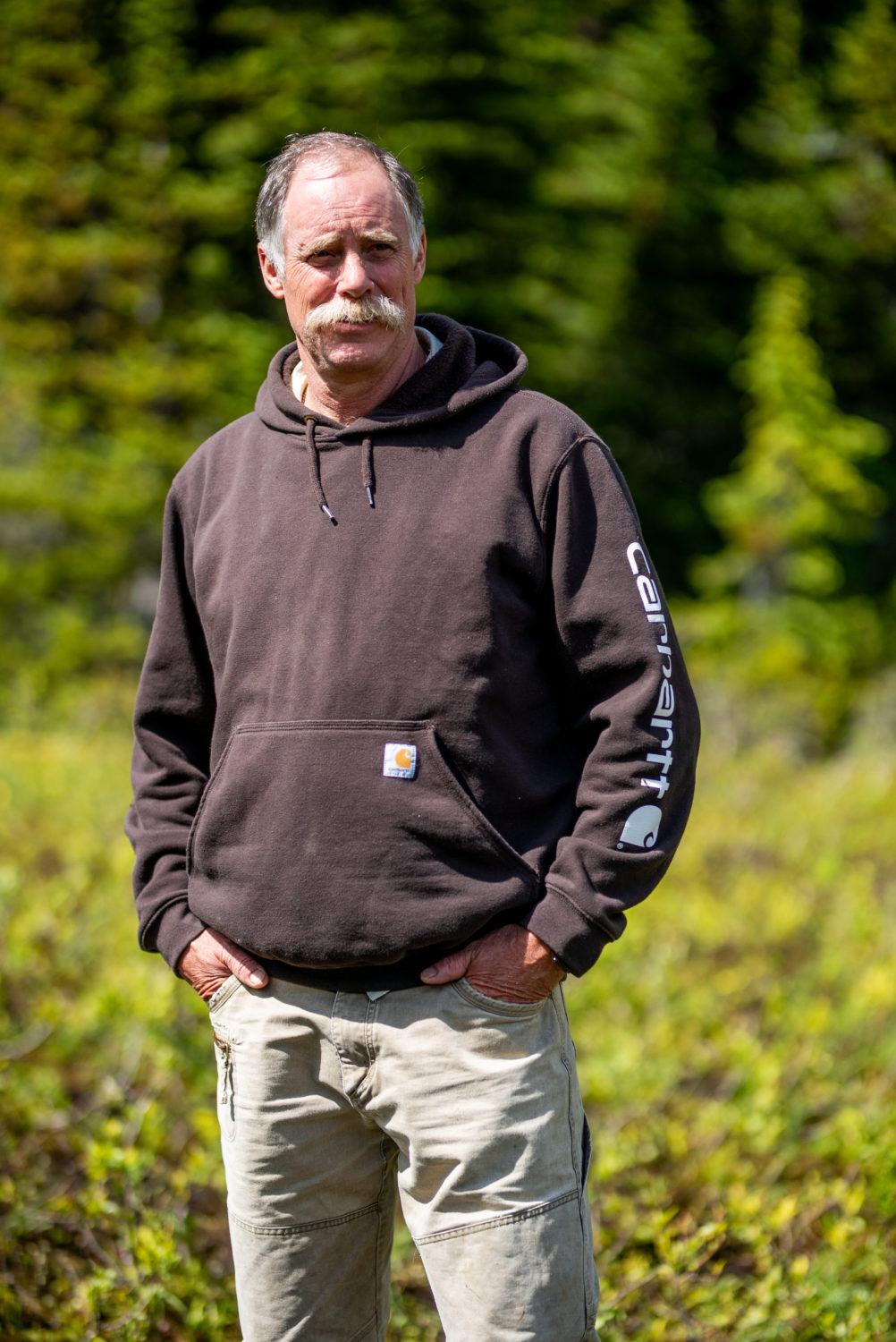
Scientist Scott McNay. Photo: Jayce Hawkins / The Narwhal
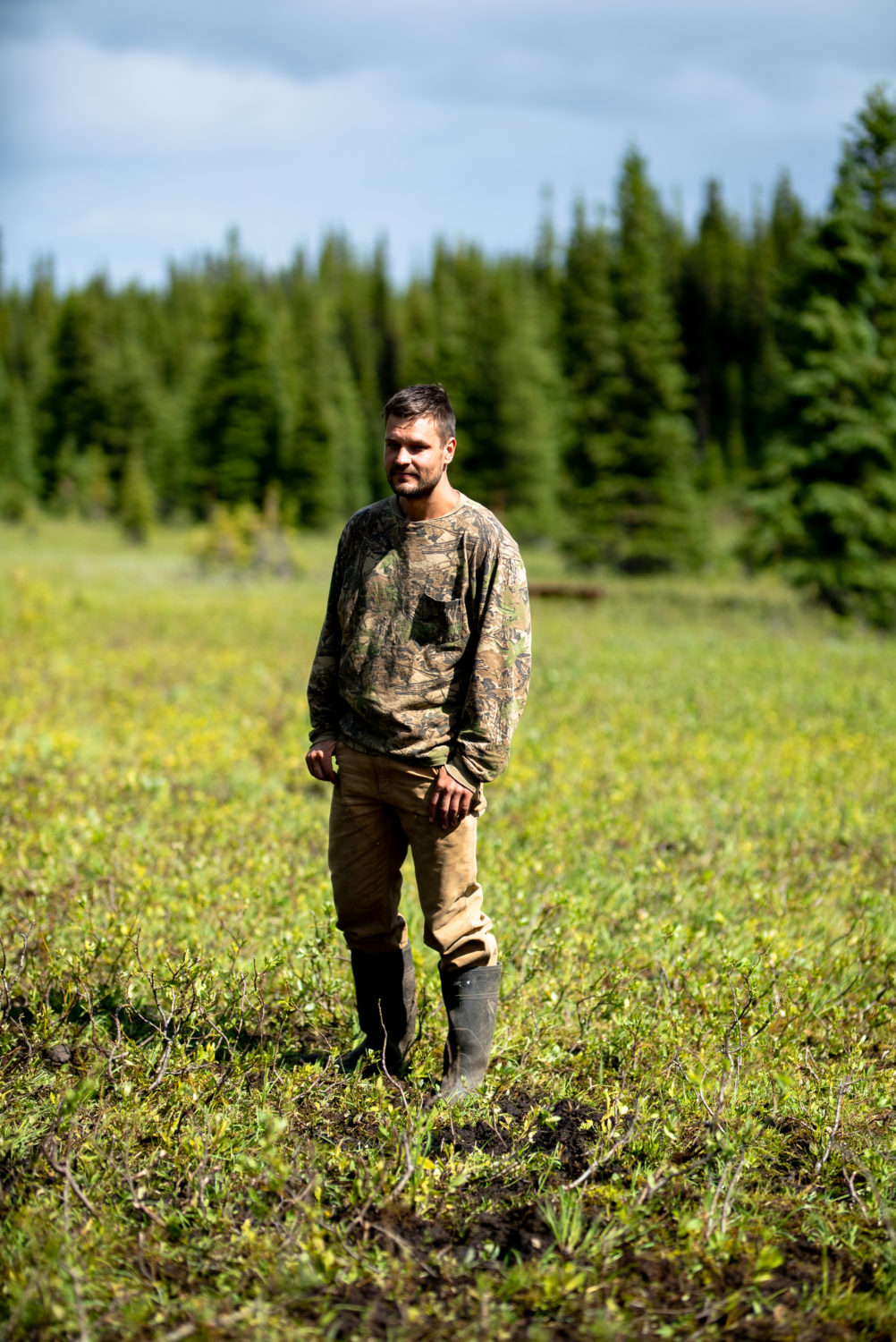
Guardian Julian Napoleon. Photo: Jayce Hawkins / The Narwhal
There, a team weighed the animal, scooped her poop to send to a lab for testing, drew three vials of blood to test for pregnancy and pathogens, plucked a clump of hair with rubber gloves for DNA testing and ran a portable ultrasound over her rump to measure body fat. They recorded the length of her legs, chest, and back, parted her milky-brown coat to check for ticks and injected a “health shot” of vitamins and deworming medication.
Then the team faded into the trees, leaving the groggy animal to struggle to her feet and eat some grey-green terrestrial lichen, hand-picked by members of Saulteau First Nations and West Moberly First Nations, partners in this Peace region maternity penning project.
For the next six months, caribou C-315S would live in the pen with 11 other caribou cows, airlifted to the enclosure in the hope they are pregnant and their calves will survive when released at three months of age. Outside the pen, at 10 months old, fewer than one out of three youngsters in this southern mountain population of woodland caribou is still alive.
“It’s kind of crazy,” Napoleon said in an interview with The Narwhal. “We have a big team of folks. We’ve got biologists, we’ve got veterinarians, we’ve got community members from Saulteau and West Moberly [First Nations]. We’ve got three helicopters for the bulk of the capture days. Once a caribou is shot with that gun everything has to happen very fast to ensure that it’s subjected to the least amount of stress possible.”
Kind of crazy, indeed. As the adage goes, desperate times call for desperate measures. In the age of the Sixth Great Extinction, far-fetched and expensive efforts to save endangered species are becoming as noteworthy as movie star shenanigans. This past summer, scientists fed a starving orca whale named “Scarlet” medicated Chinook salmon from a boat, while members of her highly endangered southern resident killer whale group swam nearby in noise-polluted waters depleted of their food source.
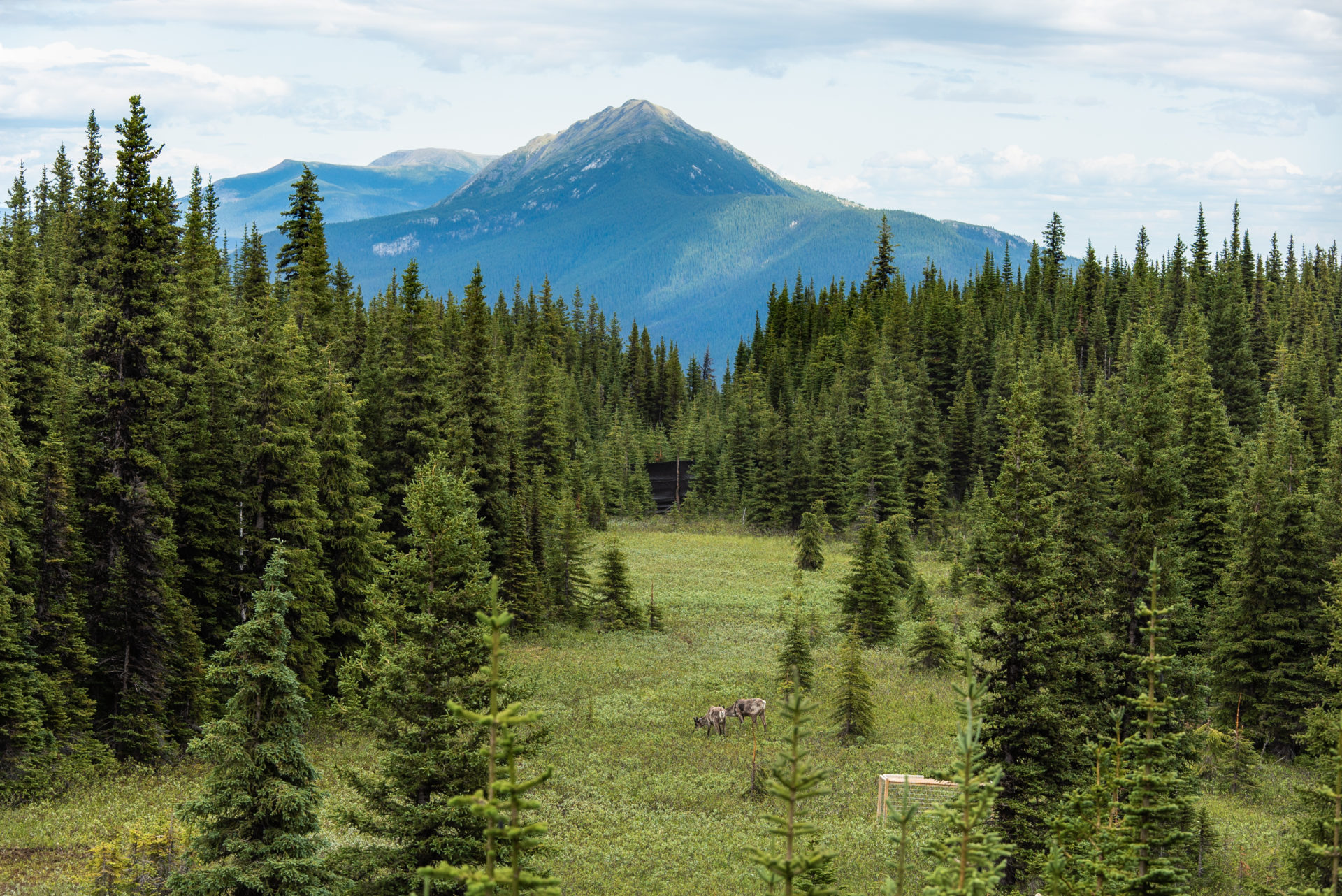
Caribou cows and their calves in their guarded enclosure. Photo: Jayce Hawkins / The Narwhal
Endangered Vancouver Island marmots are bred at the Calgary Zoo, where zookeepers sometimes parade a taxidermied cougar past cages to stimulate alarm whistles — a piercing shriek warning other marmots of imminent danger. It’s a reflex the marmots will need once they are airlifted back to Vancouver Island for release, their movements monitored through tracking devices surgically implanted in their bellies.
At a Langley facility to breed endangered spotted owls, eggs are removed from platform nests in large aviaries where owls sometimes practice catching live mice in escape-proof troughs, to hone their hunting skills if the day ever comes when the population is viable enough for release. The eggs are placed in incubators and young biologists keep vigil through the night when they begin to hatch, like parents watching their newborn in the ICU.
The endangered spotted owl breeding facility has an annual budget of $362,000, including $270,000 in funding from the B.C. government. The Vancouver Island Marmot Foundation raised $760,000 in 2017 to save a winsome rodent that looks like a super-sized squirrel with beaver teeth. And that’s just the tip of the burgeoning cost of saving endangered species from ourselves: each caribou calf born in the pen costs $125,000, according to McNay’s calculations.
As species around the world wink out at an accelerating speed — 150 to 200 plant, insect, bird and mammal species become extinct each day — scientists have isolated the primary culprit for the carnage. It’s us, human beings, and Canadians are no exception to the doleful trend. A 2017 World Wildlife Fund report found that even when endangered species like caribou are protected by Canadian law, their populations continue to decline.
Like most people, I have never seen a caribou in the wild. I know them mainly as the antlered animal engraved on the Canadian quarter: stoic, regal and frequently mistaken for a moose. In popular culture, caribou are the eulogized creatures that pull Santa’s sleigh, courtesy of an 1823 Christmas poem whose author is believed to have been high on mushrooms when he envisioned reindeer in the sky.
Most Ice Age megafauna was wiped out 10,000 years ago, at the tail end of the last glacial period. But caribou, unlike wooly mammoth and steppe bison, survived. Their presence was indispensable to First Nations, who relied on the ungulate for sweet dried meat and tasty marrow to spread on bannock, like butter or jam.
“If you needed food you could always find a caribou,” said West Moberly First Nations chief Roland Willson. “Elders told us that the caribou have always been here for us when we needed them.”
Six decades ago, so many caribou roamed the south Peace region that elders described them as like “bugs on the landscape.” But now the animal whose braided tracks have graced the planet for at least two million years, about the time Homo erectus populations first wandered out of Africa, is vulnerable to extinction throughout most of its Canadian range, which often coincides with valuable forest lands, mineral tenures and oil and gas leases.
Improbable efforts to save woodland caribou are also underway in B.C.’s Columbia Mountains, where almost $2 million has been spent over the past five years for a penning project that has stabilized the herd but not increased it. In Alberta, where lucrative oil and gas operations overlap with caribou habitat, the provincial government has floated a proposal to rescue one caribou herd by enclosing the remaining 80 animals in a massive $15 million dollar pen.
In the south Peace region, the epicenter for resource extraction in B.C., five out of six caribou herds were imperiled by 2016. A seventh herd, the Burnt Pine group, was declared functionally extirpated in 2013 despite the legal efforts of West Moberly First Nations to save the last remaining 11 animals.
The Nation went to court to try to stop a mining company, First Coal Corporation, from exploring in the Burnt Pine herd’s critical winter range. But a favourable court ruling came too late. The lone survivor, a young bull, left the area in search of others of his kind. He was never seen again.
“There’s an argument that caribou are one of these creatures that are just doomed for extinction,” said Willson, a frequent presenter at forums and seminars across North America, where he speaks about the disappearance of caribou and their cultural value to his people. “They’ll just fade out. But what’s happening here is manmade.”

West Moberly Chief Roland Willson. Photo: Jayce Hawkins / The Narwhal
For years the nations asked the B.C. government, which carefully monitors caribou herds and chronicles their demise, to prioritize herd recovery over industrial development in critical habitat. In 2014, with only 16 animals remaining in the Klinse-Za herd, named after an area that includes the sacred Twin Sisters mountains, the nations launched their own caribou recovery strategy, one that put caribou first.
The Klinse-Za herd, also known as the Moberly herd, was so close to local extinction that the nations hesitated to put all its reproductive females at risk in an untested, long-shot penning project. So the first penning experiment, at a different locale, took five females from the Klinse-Za and five from the neighbouring Scott East herd.
“We were two years away from extirpation,” McNay explained. “I remember asking First Nations how important it really is that we save these caribou, as opposed to letting the herd die and bringing them back in a reintroduction program. It was just terribly important to them that we save these caribou.”
Inside the first pen, “the animals all got to know each other,” McKay said. “It changed the social relationships. And when we released them there was a big mix between the herds. Some of the Klinse-Za animals went with the East Scott herd and the East Scott animals stayed with the Klinse-Za animals. We couldn’t really tell which herd was which any more.”
To pay for the penning project, the First Nations partnered with some of the same resource extraction companies that log, mine, frack for natural gas or build pipelines through caribou habitat.
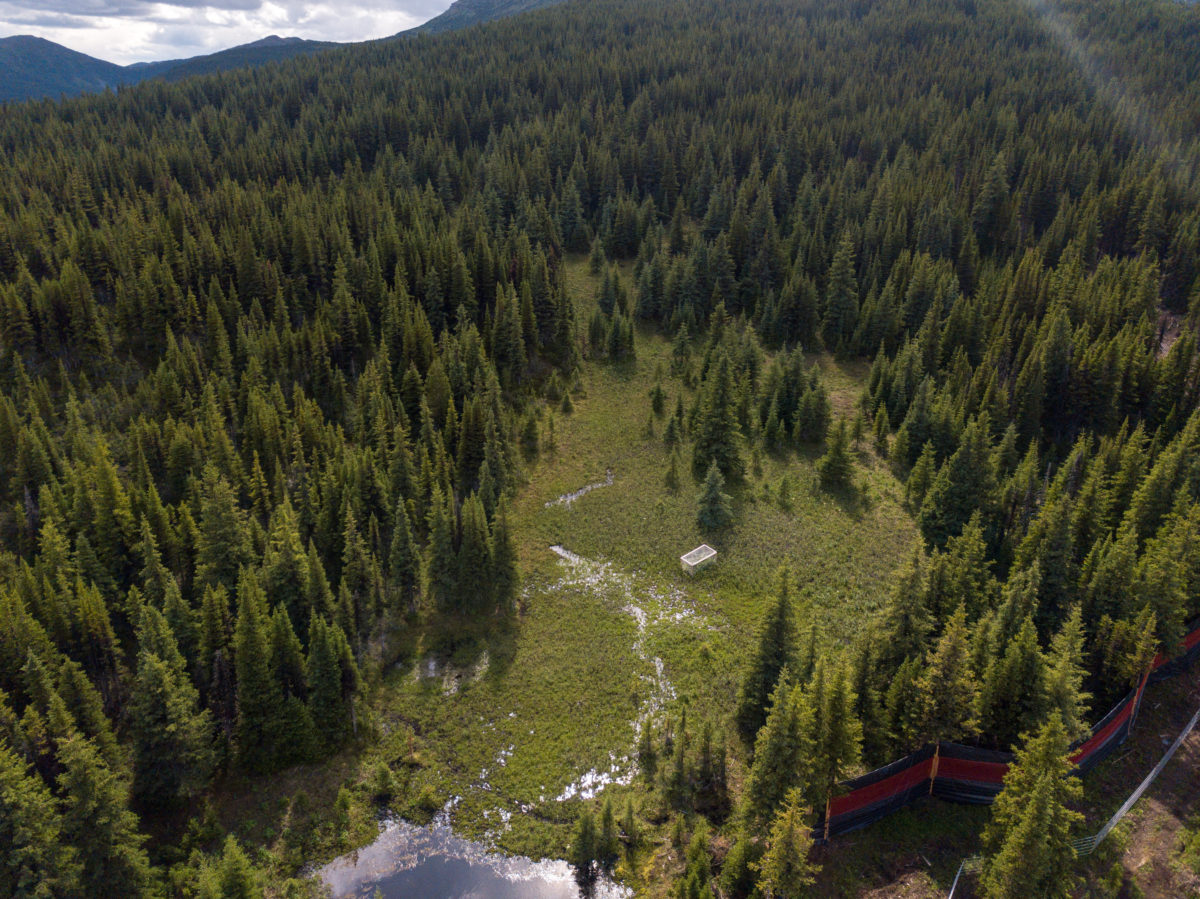
An aerial view of the caribou pen. Photo: Jayce Hawkins / The Narwhal
Sponsorship varies from year to year, but since the project’s inception the companies have included Enbridge, Canfor, West Fraser, Spectra Energy, Walter Energy, Anglo American, TransCanada, Canadian Natural and Teck.
Other sponsors are the federal government, the Habitat Conservation Trust Foundation, BC Hydro and the B.C. Oil and Gas Research and Innovation Society.
The nations convinced the B.C. government, which allows virtually unbridled resource development in caribou habitat, to eventually contribute hundreds of thousands of dollars a year for the penning enterprise. In the project’s early days, when money ran out for life support, the nations turned to crowdsourcing.
As spring bloomed in the pen in May, the first caribou calve arrived: a stillborn. Two other cows were not pregnant; one wasted away with an intractable uterine infection and was not expected to survive. But nine caribou cows delivered nine healthy calves who soon found their legs in the alpine meadow while their watchful mothers browsed on arnica, grounsel, horsetail and sedges.
In early July, as clouds scurried across the northern sky, I travelled to the pen with Willson and McNay, the mustachioed biologist who manages the project.
McNay, passing around bug spray like a box of chocolates, warned it would be a long, rough ride in his Ford Super Duty pickup truck: 71 kilometres on an active logging road, traversed by scores of loaded trucks that left a fog of grey dust and an unpleasant film in our mouths, nine kilometers on an unused logging road, and eight kilometers lurching towards the heavens on a pathway riddled with a mechanical minefield of potholes and boulders.
The two-hour journey afforded a magnified look at some of the principal reasons for the caribou’s demise. We journeyed past a logging camp with a small city of trailers, ribbons of hydro lines that cut a wide swath through the boreal forest, and a mining stake with abandoned ore samples stacked in wooden boxes.
Around a bend was a bird’s eye view of one of the octopus arms of the Williston reservoir, which 50 years ago flooded an area 15 times the size of the city of Vancouver. The reservoir, behind the W.A.C. Bennett hydro dam, jump-started the decline of local caribou populations when it severed a major migration route.
“We’re in the heart of the resource extraction zone for B.C.,” Willson said. “Everything that makes B.C. excited is happening here. We have mining, we have oil and gas, we have forestry, there’s large scale hydroelectric.”
Widespread industrial development has spawned roads, well pads, and seismic lines. By 2012, according to Global Forest Watch, there were 45,000 kilometres of roads in the Peace. Together, the region’s linear disturbances could wrap around the planet four-and-a-half times.
“There are many, many studies that show a very strong correlation between the amount of industrial disturbance on the land and the decline of caribou populations,” McNay pointed out. “As industrial disturbance increases, caribou populations decline.”
Climate change is sometimes blamed for the caribou’s demise, caribou scientist Justina Ray told The Narwhal. But that’s only “nominally” correct, explained Ray, senior scientist and president of Wildlife Conservation Society Canada.
In the past, caribou herds could adapt to the footprint of forest fires by moving their range and avoiding burned areas for several decades until they rejuvenated.
“But when you’ve got fire in conjunction with escalating human disturbance on the very same landscape you’re talking about precluding options,” Ray said. “So fire becomes an increasing threat in this situation, when you’ve already got very, very small populations struggling to survive in a very modified landscape. And then this gets even more compounded by fire increasing in frequency and intensity due to climate change.”
Sturdy, with heavy, elaborate antlers, caribou evolved over millions of years from a large South American deer. Rangifer tarandus adapted to harsh winters, with two half-moon shaped toes that grow longer in winter for grip on icy surfaces and a dense, insulating undercoat that also provides buoyancy while swimming.
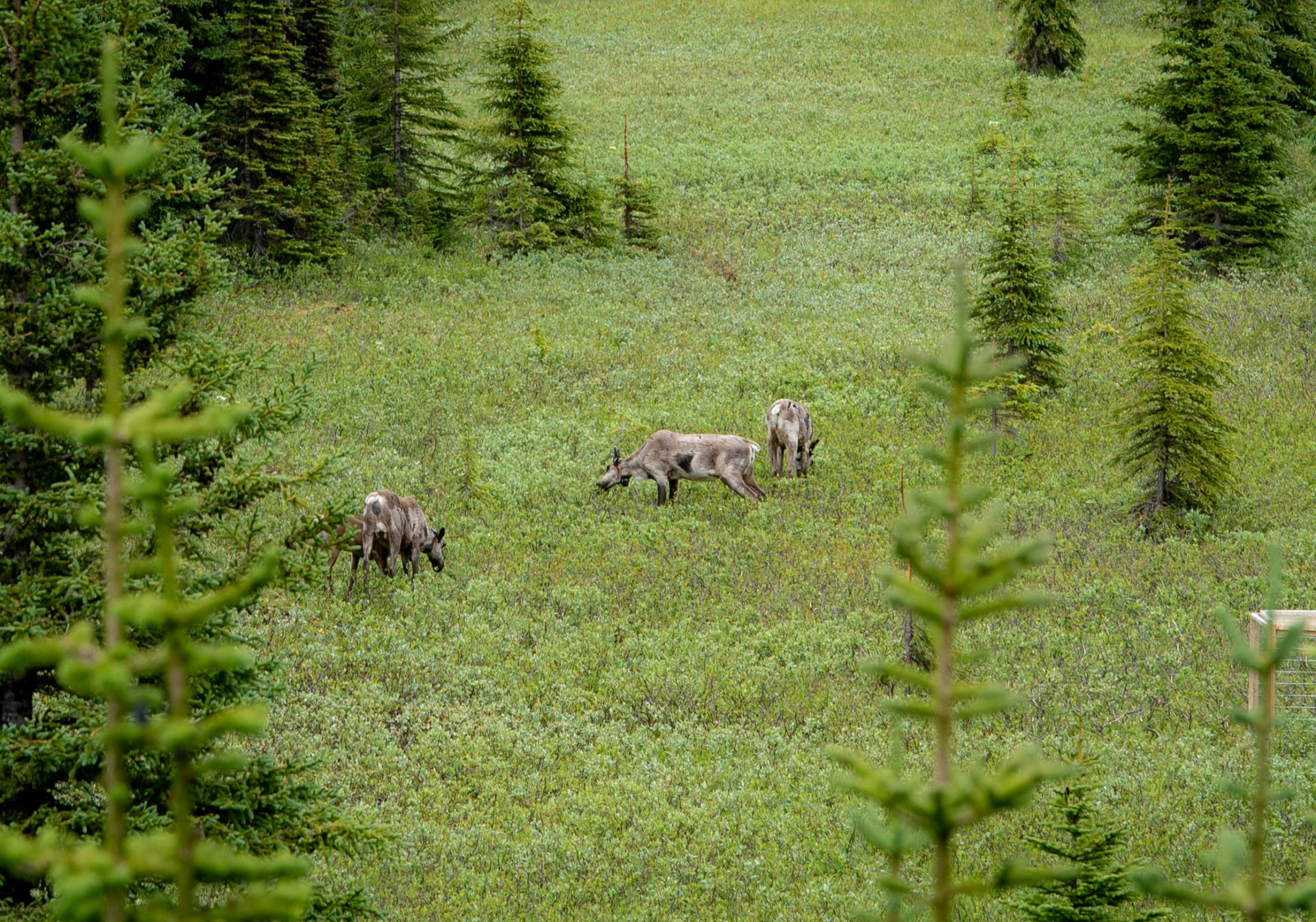
Members of the Klinse-Za caribou herd. Photo: Jayce Hawkins / The Narwhal
Southern mountain caribou populations in the Peace eat nothing but low-protein lichen from old-growth trees in mid-winter, when snow is too deep to crater for terrestrial lichen.
Clear-cut the old-growth trees and you remove a solitary mid-winter food source. Squeeze a species capable of traveling 50 kilometres in a single day into smaller and smaller areas, crisscrossed by roads and other linear disturbances, and you seal escape routes from wolves and lesser predators like grizzly bear and cougar.
As long as caribou have sufficient habitat they stand a good chance of eluding wolves and other predators. Females giving birth will naturally disperse, reducing the risk.
But ever-expanding roads and seismic lines function as highways for wolves, which are easy-target abettors in the caribou’s demise. As clear-cuts green up, browsing moose are drawn into traditional caribou habitat, inviting more wolf packs.
Moose will kick wolves so ferociously that it’s not uncommon for pack members to die even in a successful hunt. Elk herd their young into the centre of a circle and huddle around them, fighting off predators with antlers and hooves. White-tailed deer, speedy and stealthy, can outrun and outsmart their hunters. But caribou, said McNay, are “on the other side of the spectrum.” “They don’t seem to have those defense mechanisms, and rely solely on dispersing in a large intact range.”
Caribou, the only ungulate whose females have antlers, also display an inquisitiveness that begs for the adage “curiosity killed the cat” to be re-cast. Studying caribou on the Liard plateau, north of the Peace, McNay and a colleague once whipped out their laptops to type up their notes. The caribou ambled right up, eager to investigate the shiny contraptions.
“If you stand up and wave your arms back and forth like antlers you’ll get a bull coming right up,” McNay said. “It’s just wild. They are a species that really needs big open spaces of wilderness.”
Napoleon greeted us outside the pen, coffee mug in hand. A wall of black geotextile fabric enclosed the 15-hectare oval — the size of 28 football fields — constructed by Napoleon and a half-dozen others in the middle of a squally winter with snow several metres deep.
Near the pen entrance is a one-room shack where two guardians from each First Nations take turns living for a week at a time. The shack has two bunks, a small flat screen television powered by a generator, and a Coleman stove where Napoleon fried bacon for his lunch.
The pen contains a smorgasbord of natural caribou habitats, including old-growth subalpine fir and Engleman spruce with arboreal lichen, drier, rocky areas with terrestrial lichen, several feeding meadows and a stream. Following the caribou capture, and in the weeks before release at the end of July, the animals are fed lichen. Most of the time, they eat specially made caribou pellets with added vitamins from feeding troughs in the main meadow.
The guardians patrol the outside of the enclosure on ATVs, ferrying building supplies for continual pen reinforcement. They keep vigil with binoculars, rifles slung across their backs, making sure wolves, bears and cougars don’t stalk the enclosure. If they see a wolf, they shoot it.
Since 2015, in an eleventh-hour attempt to save caribou, the B.C. government has culled hundreds of wolves in the south Peace, shooting them from helicopters. In Alberta, the government has shot or poisoned more than 900 wolves since 2005.
But scientists like Ray and McNay caution that the controversial culling practice is only a short-term emergency measure. In biology circles, along with penning, it’s known as “intensive management.”
“If you don’t improve the conditions into which you’re releasing these poor things over time, then you will have to do this again and again every year,” Ray said. “And that’s hugely expensive.”
Until governments are prepared to take the political-hot potato step of reducing and restricting resource extraction in caribou habitat, scientists say herds in the south Peace and elsewhere will continue to decline, with more becoming locally extinct.
“Nobody wants to limit the [industrial] footprint,” Ray said. “They just want to manage what they’ve got….We’re sitting on a legacy of many decades of thinking there’s more than there is, that resources are abundant. You’re in a situation where people have expectations that this will continue indefinitely.”
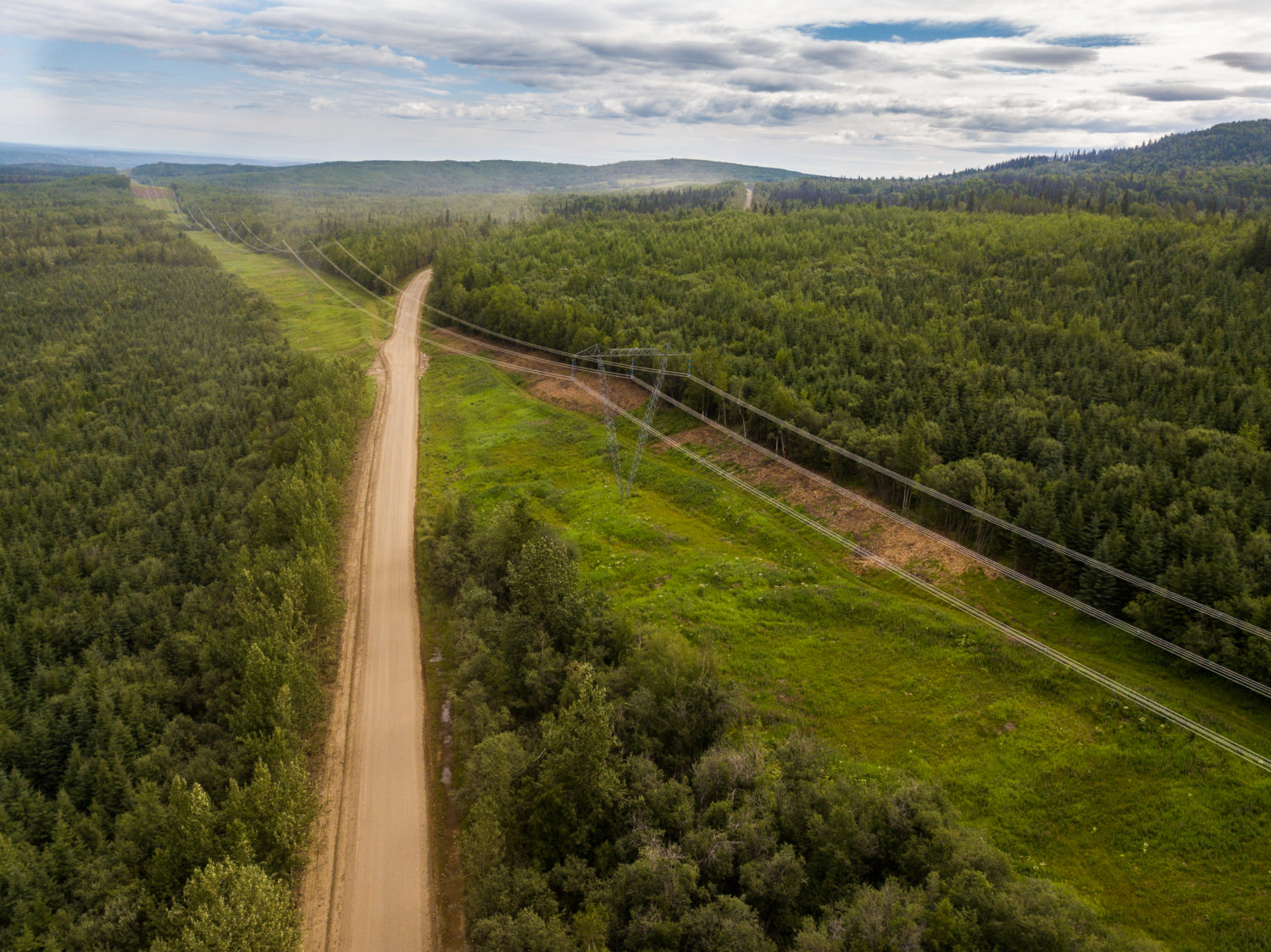
Northeast B.C. is home to some of the province’s most industrialized landscapes. Photo: Jayce Hawkins / The Narwhal
Reconciling different viewpoints about land use is extremely difficult and the longer governments wait to “put their foot down,” the harder it will be, Ray pointed out. “Plus even if you put your foot down it’s still going to require extraordinary investment and stopping development in some places — and even that might not be successful given the forces of climate change and the fact that we may have gone too far.”
There’s no point in protecting and restoring caribou habitat — by decommissioning roads, planting trees in tricky high-elevation cut-blocks and limiting recreational uses — if more habitat is simultaneously destroyed, McNay noted.
“You wouldn’t go out and restore one road when five new roads are getting built. It’s really important to understand that concept. The basis for getting [to recovery] is either to do one heck of a lot of restoration or curtail some of the industrial disturbance. Somewhere there’s a balance.”
As a small measure of how much habitat restoration will cost, Cenovus Energy recently committed $32 million over 10 years for a caribou habitat restoration project in the range of the Cold Lake caribou herd, whose habitat overlaps with Cenovus oilsands sites. That’s $3.2 million per year to help one herd.
Compare that, McNay said, to B.C.’s commitment of $27 million over five years to assist 30 herds out of 52 that are in need of recovery. That boils down to about $900,000 per herd, according to McNay’s analysis, and about $100,000 has already been spent.
“Really what we’re looking at is $200,000 on average per herd per year,” compared to $3.2 million annually for one Alberta herd. “That’s a pretty big difference.”
Guided by Napoleon, we crossed the electric fence and slipped through the pen door. After squelching through a bog and a few twists and turns through the forest, we climbed a short ladder to a wooden lookout platform in a fir tree.
Peeking into the green meadow, speaking sotto voce, we spotted one caribou cow munching sedges, a mocha-coloured calf close to her side. Three more caribou appeared with their multi-sized offspring. The youngsters, with their dark muzzles and over-sized ears, resembled German Shepherd puppies on stilts.
“They are pretty gentle and incredibly affectionate animals,” said Napoleon. “They’re pretty special critters. We need them. They’re precious. I want all of them to survive.”
After four years, the penning project is achieving some success. Herd size has increased by 13 per cent a year, to 66 animals. Last year, all seven calves born in the pen survived their first year, compared to four out of nine calves released in 2014. The 10-month survival rate for calves born in the pen is close to 60 per cent, double that of calves born in the wild.
“The whole thing ultimately really has to boil down to habitat restoration and protection,” said McNay, pointing out that the herd needs to have 200 animals to be sustainable. “Ultimately that’s the real deal. That’s what has to happen. And we have to get there one way or another. Otherwise all this is for naught.”
On July 31, two guardians from West Moberly First Nations switched off power to the electric fence. They removed several panels of the geotextile fabric and placed the feeding troughs outside the pen, adding handfuls of terrestrial lichen. They had already cut a trail to the high alpine in order to expedite travel for the herd and, with any luck, avoid grizzly bears sighted earlier near the pen.
Rifles at the ready, in case any wolves appeared out of the ether, the guardians waited for the caribou to discover the exit. At 6:30 p.m., after 141 days in the maternity pen, the females left as a group, youngsters by their sides.
As of early September, all were still alive.
“We’re going to do everything we can to make sure that our grandchildren have caribou,” Willson said. “I hope that my grandchildren can hunt a caribou or see a caribou, and not just look at them on the back of our quarter.”
This report was produced with financial assistance from the Unchartered Journalism Fund.
Get the inside scoop on The Narwhal’s environment and climate reporting by signing up for our free newsletter. On a warm September evening nearly 15...
Continue reading
115 billion litres, 70 years to fix, $5.5 billion in lawsuits

Climate change, geopolitics and business opportunities power a blue economy

10 billion litres of sewage are dumped into Winnipeg’s lakes and rivers each year. Some...
